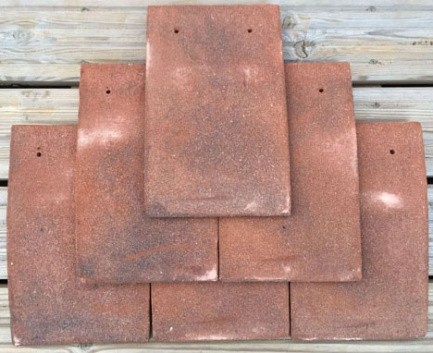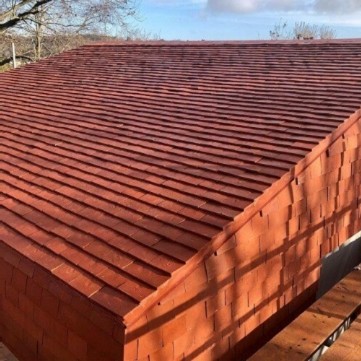Handmade Roof Tiles in Buckinghamshire
Heritage Tiles: Emblematic of the finest craftsmanship
Heritage tiles are the professional roofer's choice for the highest quality clay roof tiles. We pride ourselves in manufacturing, stocking, and delivering the very finest in prestige clay roof tiles.
Heritage Tiles have several tile ranges that satisfy every architectural requirement. Vintage and historic properties right up to modern new builds are covered by the diverse range of clay roof tiles that we stock.
So, whether you are in the building trade, or simply wish to choose your own tiles, Heritage Tiles have the right product for your specific requirements.
What Heritage Tiles have to offer our customers?
- We offer specification and technical solutions to help you achieve the perfect build.
- We also offer expert design advice to all our customers.
- We are happy to engage in site visits with our clients.
- We have stockists and distributors throughout the United Kingdom to ensure that we can provide our expert service to a wider area.
- We can provide estimated quantities from plans supplied by our clients.
- We offer battening plans.
- We can deliver a standard and bespoke colour choice for our clay tile products.
- All our tiles are assessed and approved by Lucideon.
- We provide a nationwide delivery and collection service.
The ranges of clay roof tiles we supply.
The Clayhall Range of roof tiles:

Clayhall Medium Blend - Carefully crafted to replicate all the features of handmade the Clayhall hand crafted range of tiles offers an excellent alternative when budget restrictions are a concern, but without compromising quality or durability.
Clayhall Dark Blend - Quality and durability in a budget clay roof tile. The Clayhall dark blend is sure to turn heads.
Clayhall Red Blend - A beautiful rustic clay roof tile. The Clayhall red blend is a firm favourite with our customers.
Clayhall Hamlet Mix - The Clayhall Hamlet mix is a gorgeous light and sandy looking clay roof tile that is a perennial favourite in the building trade.
Clayhall Birchwood Mix - The Clayhall Birchwood mix offers a gorgeous blend of lighter and darker shades in this diverse clay roof tile. If you are concerned that your roof tiles could look monotonous, the Clayhall Birchwood mix is the clay roof tile to choose.
The Conservation Range of roof tiles

The Conservation range of roof tiles are available in a range of distinctive colours, created by using a very fine sand, The Conservation Weathered; A natural warm tone, achieving an instant mellow and settled look and The Conservation Red; perfect for vertical tiling especially suited for villages and hamlets with olde world vernacular charm.
Manufactured using high quality clay, achieving high strength and durability properties, giving homeowners and contractors peace of mind for many years to come. The conservation range comes with a complete set of associated fittings, including Hog Back Ridge, Half Round Ridge, Bonnet Hips, Valley tiles and External Angles.
The Conservation range of clay roof tiles comes in the following variations:
- Conservation Red
- Conservation Weathered
- Conservation Dark
Conservation Peg Tile
Plain clay roofing tiles laid to a double lap have been used for roof covering in England since before the Norman Conquest and tiles dating back to Roman Times have been discovered under excavation. From the outset clay plain tiles were made incorporating fixing features.
The Classic Edwardian roof tile
The Classic range of plain tiles is one of the finest ranges of clay tiles.
We source only the best raw materials for our craftsman to create beautifully handmade clay tiles of the highest quality and durability.
Tile Fittings available from Heritage Tiles
There are many fittings that are available from us a Heritage Tiles to complete your build to perfection. We stock and supply the following:
- Gable Tile
- Eave Tile
- Baby Porch Ridge
- 90 Degree Ext. Angle
- Universal Bonnet Hip
- Half Round Ridge
- Hogs Back Ridge
- Mono Ridge
- Third Round Ridge
- Universal Valley
- Ornamental Club
- Bat Tile Set
Bat Tiles:
Provide help for our bats with our range of bat friendly roof tiles.
Did you know that all UK bats and their roosts are protected by law? The Wildlife and Countryside Act introduced in 1981, gave legal protection to all bat species and their roosts in England.
Distinct species of bats prefer differing places to roost. The two most usually found species of bat in the UK are the Pipistrelle and Brown Long-Eared Bat. Pipistrelle prefer confined spaces such as under tiles on roofs and hanging spaces. The Brown Long-Eared Bat prefer roof timbers and ridges inside lofts. Heritage Clay Tiles can provide purpose made access points within your roof tiles or ridge tiles. The Bat Tile Set can form part of a mitigation package required by law for existing roosts or as potential access where a roost had not previously been present.
Select a Blend
Getting the right blend for your roofing project can feel daunting, but with our blend generator you can mix and match various blends of tiles to achieve the perfect blend.
Click here to make use of our online tool to choose your own unique blend.
Because our strict quality control provides a consistent tile size you can mix assorted styles and colours of tiles to make your roof unique to you. Please use the tool below to experiment with various blends.
Adjust the sliders to set the ingredients for your desired blend then click on the update mix button.
Alternatively click on any blend or tile to display it.
Whatever type of clay roof tile you want, Heritage Tiles will be able to help.
Handmade Roof Tiles
Handmade roof tiles: Perfection for your building project
With the prices of property so high, more and more people are choosing to extend their existing property, rather than sell up and move somewhere else. They tend to match the bricks and other elements such as doors and windows, but it's surprising at how many properties don't have matching roof tiles.
When you have a property that has handmade roof tiles on the main house and machine made roof tiles on the extension, it sticks out like a sore thumb. Matching the handmade roof tiles with a similar product these days is much easier than it used to be. Colour and texture matching of handmade roof tiles is a major consideration when it comes to making the new extension blend into the existing property.
Clay handmade roof tiles
Clay roof tiles are suitable for both traditional and modern homes, and come in a very attractive range of colours, from warm reds and oranges to rich blues and greys. The textures present on handmade roof tiles are very pleasing too and are rarely matched by machine made alternatives.
The material you choose for your roof plays a vital role in establishing the overall character of your property, and few materials match the warm, handmade appeal of clay. Clay is a natural product and a handmade roof tile enhances the natural beauty of the property like no other product can.
The Benefits of handmade roof tiles
One of the advantages of choosing clay handmade roof tiles is that they're made from a natural material, which means your tiles will never fade, they will simply look better as the years roll by. Handmade roof tiles are like a fine wine, they only get better with age. This is down to the natural weathering that deepens the shade and colouring of the handmade roof tile over time. Alternative roofing materials that have been artificially pigmented, such as concrete, eventually fade due to exposure to UV light.
Handmade roof tiles come in many different sizes and profiles, from plain and S-shaped pantile units to more decorative designs, such as bullnose and club tiles. The other beauty of the handmade roof tile is that it can be custom built to your exact specification. Sure, they'll cost more, but true quality always will.
Handmade roof tiles are very durable and have amazing longevity. The handmade roof tile will also help to protect the property against the effects of the elements that attack a property all year round.
Handmade roof tiles age gracefully
Handmade roof tiles will transform your property. They look amazing and the gorgeous texture will encourage lichen to adhere, simply adding to the natural beauty as the tile ages. Like any other roof tile, handmade roof tiles are relatively fragile, and shouldn't be walked on and one should always use crawling boards when maintenance is carried out.
Handmade roof tiles stand up to inclement weather very well, but like any roof tile, they may become loose and fall off in very high winds.
Handmade roof tiles are not necessarily the cheapest option for your roofing requirements, so if you are on a very tight budget, a cheaper option may be the solution, but as the saying goes, you get what you pay for!
The making of handmade roof tiles
Clay is dug from the earth and then aged for a few months to allow any soluble salts to leech out. Next, it is worked to the correct particle size and water content, depending on the type of tile needed. The material is then formed into a tile, either by hand. The face colour of the tile is achieved by pressing sand into the surface of the clay and by the firing conditions inside the kiln.
After an extensive drying period, the tiles are fired in kilns to the correct temperature, depending on the type of clay used. A good quality handmade roof tile needs to be the correct size, shape and colour, and frost resistant to certified standards. To achieve this, quality control measures are adhered to at various stages throughout the manufacturing process.
How long do handmade roof tiles last?
Providing they're fitted correctly and well maintained, a good quality handmade roof tile has a pretty impressive lifespan. Most manufacturers of handmade roof tiles guarantee their products for between thirty and fifty years, and in reality if you care for your tiles it's not unreasonable to expect them to last over sixty years. Clearly, there are examples of some handmade roof tiles lasting for many centuries, but these have been found on archaeological digs, so the efficacy for weather proofing has not been put to the test.
Of course, the longevity of your handmade roof tiles depends on the conditions. Moss and lichen will grow more readily on damp clay, so be sure to keep your gutters clear from debris to allow rainwater to be channelled away from your roof effectively, but above all, enjoy the beauty of your handmade roof tiles for many years to come.
A little information about Buckinghamshire
History of Chesham in Buckinghamshire
This part of Buckinghamshire revealed archaeological evidence of the earliest settlement during the Late Mesolithic period around 5000 BC in East Street, Chesham where large quantities of flint tools were found. The earliest farming evidence from the Neolithic era around 2500 BC. Bronze Age tribes settled in the Buckinghamshire valley around 1800 BC and they were succeeded by Iron Age Belgic people of the Catuvellauni tribe around 500 BC. Between 150 and 400 AD, there is evidence of Romano-British farming, and nearby at Latimer, there is archaeological evidence of a Roman villa and the planting of grapevines, proving Roman habitation in this part of Buckinghamshire. The Buckinghamshire area was then deserted until the Saxon period around the 7th century.
Contrary to popular belief, the Buckinghamshire town is not named after the river; but the other way round. The first recorded reference to Chesham is under the Old English name Caestaeleshamm, meaning "the river-meadow at the pile of stones" around 970 in the will of Lady Aelfgifu, who has been identified with the former wife of King Eadwig. She held an estate here which she bequeathed to Abingdon Abbey.
Prior to the Norman Conquest, there were three adjacent estates which comprised Caestreham which are briefly recorded in the Domesday Book as having four mills. The most important of these manors was held by Queen Edith, the widow of Edward the Confessor, with other parts of Buckinghamshire having been returned to the Crown. Part of these later became Chesham Bois parish. After 1066 Edith kept her lands and William the Conqueror divided royal lands between his half brother Odo, Bishop of Bayeux and Hugh de Bolbec.
The land owners of Chesham in Buckinghamshire
The Domesday Book records that there were three manors in Cestreham and one at nearby Latimer. William the Conqueror shared out the estates between four of his dependants. The vast majority of his land in Buckinghamshire was granted to Hugh de Bolebec and smaller parcels to Odo, Bishop of Bayeux, Toustain Mantel and Alsi.
Before the 13th century, the three Cestreham manors were known as Chesham Higham, Chesham Bury and Chesham Bois. In the 14th century they were first recorded as the manors of Great Chesham. Collectively they extended beyond the current Chesham town boundary. Together with the manor at Latimer they were held by the Earls of Oxford and Surrey. During the 16th century Greater Chesham was owned by the Seymour family who disposed of it to the Cavendish family who were the Earls and later Dukes of Devonshire. It is from the 15th century that the earliest surviving properties survive and are to be found close by the church in an area called the Nap, and along part of the present-day Church Street.
Evidence of churches in this part of Buckinghamshire
Although there appears to be no remains of any church prior to the Norman Conquest in this part of Buckinghamshire, the discovery of puddingstones beneath the present-day church suggests a wooden church was constructed on the site during the Anglo-Saxon period. During the 12th century two families of Norman descent, the de Bolebecs and the Sifrewasts, each held a share of the land.
Religious dissent in Buckinghamshire
Chesham is noted for the religious dissent which dominated the Buckinghamshire town from the 15th century. In 1532 Thomas Harding was burnt at the stake in the town for being a Lollard and heretic. From the 17th century, Chesham was a focus for those dissenting from mainstream religion.
The Quakers movement was rising in Buckinghamshire at this time and they met in the late 17th century in Chesham and in 1798 they built the current meeting house. The first Baptists' meeting dates back to about 1640 and a place was registered for services in 1706. The first chapel was opened in 1712, one of many to be built for the various Baptist groups during the 18th and 19th centuries. John Wesley preached in this part of Buckinghamshire in the 1760s and a Wesleyan Methodist society existed in the town.
Products available from Heritage Clay Tiles Ltd in East Sussex
Clay Roof Tiles in East Sussex
Clayhall Roof Tiles in East Sussex
Conservation Roof Tiles in East Sussex
Edwardian Roof Tiles in East Sussex
Victorian Roof Tiles in East Sussex
Georgian Roof Tiles in East Sussex
Handmade Clay Tiles in East Sussex
Handmade Roof Tiles in East Sussex
High Quality Roof Tiles in East Sussex
Traditional clay tiles in East Sussex
Traditional roof tiles in East Sussex
Products available from Heritage Clay Tiles Ltd in Essex
Conservation Roof Tiles in Essex
High Quality Roof Tiles in Essex
Traditional clay tiles in Essex
Traditional roof tiles in Essex
Products available from Heritage Clay Tiles Ltd in Hampshire
Clayhall Roof Tiles in Hampshire
Conservation Roof Tiles in Hampshire
Edwardian Roof Tiles in Hampshire
Victorian Roof Tiles in Hampshire
Georgian Roof Tiles in Hampshire
Handmade Clay Tiles in Hampshire
Handmade Roof Tiles in Hampshire
High Quality Roof Tiles in Hampshire
Traditional clay tiles in Hampshire
Traditional roof tiles in Hampshire
Products available from Heritage Clay Tiles Ltd in Hertfordshire
Clay Roof Tiles in Hertfordshire
Clayhall Roof Tiles in Hertfordshire
Conservation Roof Tiles in Hertfordshire
Edwardian Roof Tiles in Hertfordshire
Victorian Roof Tiles in Hertfordshire
Georgian Roof Tiles in Hertfordshire
Handmade Clay Tiles in Hertfordshire
Handmade Roof Tiles in Hertfordshire
High Quality Roof Tiles in Hertfordshire
Traditional clay tiles in Hertfordshire
Traditional roof tiles in Hertfordshire
Products available from Heritage Clay Tiles Ltd in Kent
Conservation Roof Tiles in Kent
High Quality Roof Tiles in Kent
Traditional clay tiles in Kent
Traditional roof tiles in Kent
Products available from Heritage Clay Tiles Ltd in London
Conservation Roof Tiles in London
Edwardian Roof Tiles in London
Victorian Roof Tiles in London
High Quality Roof Tiles in London
Traditional clay tiles in London
Traditional roof tiles in London
Products available from Heritage Clay Tiles Ltd in Surrey
Conservation Roof Tiles in Surrey
Edwardian Roof Tiles in Surrey
Victorian Roof Tiles in Surrey
High Quality Roof Tiles in Surrey
Traditional clay tiles in Surrey
Traditional roof tiles in Surrey
Products available from Heritage Clay Tiles Ltd in West Sussex
Clay Roof Tiles in West Sussex
Clayhall Roof Tiles in West Sussex
Conservation Roof Tiles in West Sussex
Edwardian Roof Tiles in West Sussex
Victorian Roof Tiles in West Sussex
Georgian Roof Tiles in West Sussex
Handmade Clay Tiles in West Sussex
Handmade Roof Tiles in West Sussex
High Quality Roof Tiles in West Sussex
Traditional clay tiles in West Sussex
Traditional roof tiles in West Sussex
Products available from Heritage Clay Tiles Ltd in Bedfordshire
Clay Roof Tiles in Bedfordshire
Clayhall Roof Tiles in Bedfordshire
Conservation Roof Tiles in Bedfordshire
Edwardian Roof Tiles in Bedfordshire
Victorian Roof Tiles in Bedfordshire
Georgian Roof Tiles in Bedfordshire
Handmade Clay Tiles in Bedfordshire
Handmade Roof Tiles in Bedfordshire
High Quality Roof Tiles in Bedfordshire
Traditional clay tiles in Bedfordshire
Traditional roof tiles in Bedfordshire
Products available from Heritage Clay Tiles Ltd in Berkshire
Clayhall Roof Tiles in Berkshire
Conservation Roof Tiles in Berkshire
Edwardian Roof Tiles in Berkshire
Victorian Roof Tiles in Berkshire
Georgian Roof Tiles in Berkshire
Handmade Clay Tiles in Berkshire
Handmade Roof Tiles in Berkshire
High Quality Roof Tiles in Berkshire
Traditional clay tiles in Berkshire
Traditional roof tiles in Berkshire
Products available from Heritage Clay Tiles Ltd in Buckinghamshire
Clay Roof Tiles in Buckinghamshire
Clayhall Roof Tiles in Buckinghamshire
Conservation Roof Tiles in Buckinghamshire
Edwardian Roof Tiles in Buckinghamshire
Victorian Roof Tiles in Buckinghamshire
Georgian Roof Tiles in Buckinghamshire
Handmade Clay Tiles in Buckinghamshire
High Quality Roof Tiles in Buckinghamshire
Traditional clay tiles in Buckinghamshire
Traditional roof tiles in Buckinghamshire
Products available from Heritage Clay Tiles Ltd in Cambridgeshire
Clay Roof Tiles in Cambridgeshire
Clayhall Roof Tiles in Cambridgeshire
Conservation Roof Tiles in Cambridgeshire
Edwardian Roof Tiles in Cambridgeshire
Victorian Roof Tiles in Cambridgeshire
Georgian Roof Tiles in Cambridgeshire
Handmade Clay Tiles in Cambridgeshire
Handmade Roof Tiles in Cambridgeshire
High Quality Roof Tiles in Cambridgeshire
Traditional clay tiles in Cambridgeshire
Traditional roof tiles in Cambridgeshire
Products available from Heritage Clay Tiles Ltd in Oxfordshire
Clay Roof Tiles in Oxfordshire
Clayhall Roof Tiles in Oxfordshire
Conservation Roof Tiles in Oxfordshire
Edwardian Roof Tiles in Oxfordshire
Victorian Roof Tiles in Oxfordshire
Georgian Roof Tiles in Oxfordshire
Handmade Clay Tiles in Oxfordshire
Handmade Roof Tiles in Oxfordshire
High Quality Roof Tiles in Oxfordshire
Traditional clay tiles in Oxfordshire
Traditional roof tiles in Oxfordshire
Products available from Heritage Clay Tiles Ltd in Suffolk
Clayhall Roof Tiles in Suffolk
Conservation Roof Tiles in Suffolk
Edwardian Roof Tiles in Suffolk
Victorian Roof Tiles in Suffolk
Georgian Roof Tiles in Suffolk
Handmade Clay Tiles in Suffolk
Handmade Roof Tiles in Suffolk
High Quality Roof Tiles in Suffolk
Traditional clay tiles in Suffolk
Traditional roof tiles in Suffolk
Further Information
If you would like to know more or are interested in a quote we would be happy to help. Phone us on 01634 471 344, email us at sales@heritagetiles.co.uk and we will be in touch as soon as possible.







